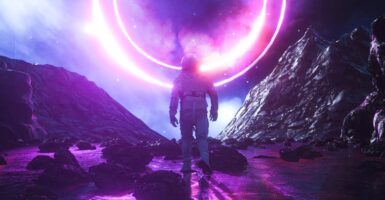Researchers Find Evidence Of The Planet That Crashed Into Earth To Form The Moon
This article is more than 2 years old
 Back in the 1970s, scientists first hypothesized that the moon was formed when another planet, now called Theia, collided with a young Earth, roughly 4.5 billion years ago. The problem with that theory, though, is that computer models indicated that the moon would then have the same composition as the other planet, but the Earth and the moon are very similar in composition. In 2012, scientists found a way to reconcile that discrepancy — if the Earth was rotating much faster than it is now, then a big chunk of Earth’s mantle broke off during the collision, slowing the Earth’s rotation down and explaining why the Earth and the moon are so similar. But now, there’s another explanation — researchers have found material from Theia in a lunar rock found by Apollo astronauts, and it turns out Theia’s composition isn’t so different from Earth’s.
Back in the 1970s, scientists first hypothesized that the moon was formed when another planet, now called Theia, collided with a young Earth, roughly 4.5 billion years ago. The problem with that theory, though, is that computer models indicated that the moon would then have the same composition as the other planet, but the Earth and the moon are very similar in composition. In 2012, scientists found a way to reconcile that discrepancy — if the Earth was rotating much faster than it is now, then a big chunk of Earth’s mantle broke off during the collision, slowing the Earth’s rotation down and explaining why the Earth and the moon are so similar. But now, there’s another explanation — researchers have found material from Theia in a lunar rock found by Apollo astronauts, and it turns out Theia’s composition isn’t so different from Earth’s.
The finding confirms the collision theory, which, because of lack of definitive evidence, was starting to gather skeptics. But now, according to University of Goettingen lead researcher Daniel Herwartz, “we have discovered small differences between the Earth and the Moon.” Theia is thought to have broken apart after its impact with Earth; its debris likely combined with Earth debris to form the moon. Scientists are surprised that the Theian remains in the lunar rock are still so similar to Earth’s composition — generally, Martian and other meteorites have markedly different oxygen isotopes than those of Earth, giving them different signatures. But Earth and Theia’s signatures are apparently quite similar, which is causing some skeptics to wonder if perhaps the Earth absorbed material after the Earth was broken off from it, accounting for the difference in the composition of the rocks.
One explanation is that Theia and Earth formed in close proximity, but that does mean that the long-held theory that each planet has its own signature may not be accurate. Since none of the meteorites we have originated from Venus or Mercury, it’s hard to know how much those samples would differ from those of other planets. If those planets have a composition similar to Earth, then “all the arguments over the similarities of the Earth and the Moon fall away,” says Oxford University’s Alex Halliday.
Another theory proposed by a Groningen University professor who believes the differences in the lunar rock and the Earth are too slim is that it wasn’t a collision that formed the moon, but rather a nuclear explosion some 2,000 miles under the Earth’s surface that released debris that later formed the moon. Regardless, scientists realize that the three rock samples from the moon may not tell the whole story — they’ll need to analyze more samples from the moon.












